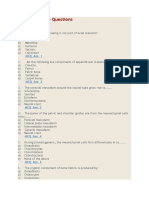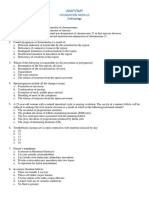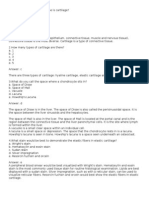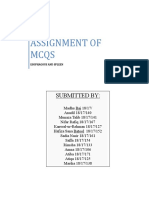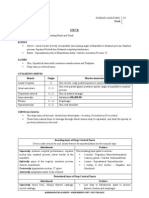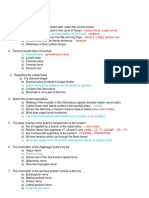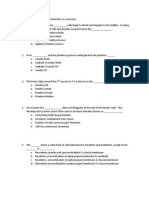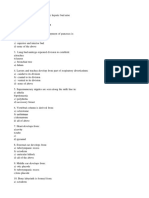100%(1)100% found this document useful (1 vote)
218 viewsEmbryology Mcqs
Embryology Mcqs
Uploaded by
Moses AjiwekaThis document contains multiple choice questions about embryology. The questions cover topics like oogenesis, implantation, spermatogenesis, fertilization, early development of spermatogonia and oogonia, and development during the second week. The questions test understanding of processes such as when oogenesis begins and ends, what occurs during implantation, the origin and development of sperm and egg cells, and cellular changes in early embryonic development.
Copyright:
© All Rights Reserved
Available Formats
Download as PDF, TXT or read online from Scribd
Embryology Mcqs
Embryology Mcqs
Uploaded by
Moses Ajiweka100%(1)100% found this document useful (1 vote)
218 views2 pagesThis document contains multiple choice questions about embryology. The questions cover topics like oogenesis, implantation, spermatogenesis, fertilization, early development of spermatogonia and oogonia, and development during the second week. The questions test understanding of processes such as when oogenesis begins and ends, what occurs during implantation, the origin and development of sperm and egg cells, and cellular changes in early embryonic development.
Original Title
embryology mcqs
Copyright
© © All Rights Reserved
Available Formats
PDF, TXT or read online from Scribd
Share this document
Did you find this document useful?
Is this content inappropriate?
This document contains multiple choice questions about embryology. The questions cover topics like oogenesis, implantation, spermatogenesis, fertilization, early development of spermatogonia and oogonia, and development during the second week. The questions test understanding of processes such as when oogenesis begins and ends, what occurs during implantation, the origin and development of sperm and egg cells, and cellular changes in early embryonic development.
Copyright:
© All Rights Reserved
Available Formats
Download as PDF, TXT or read online from Scribd
Download as pdf or txt
100%(1)100% found this document useful (1 vote)
218 views2 pagesEmbryology Mcqs
Embryology Mcqs
Uploaded by
Moses AjiwekaThis document contains multiple choice questions about embryology. The questions cover topics like oogenesis, implantation, spermatogenesis, fertilization, early development of spermatogonia and oogonia, and development during the second week. The questions test understanding of processes such as when oogenesis begins and ends, what occurs during implantation, the origin and development of sperm and egg cells, and cellular changes in early embryonic development.
Copyright:
© All Rights Reserved
Available Formats
Download as PDF, TXT or read online from Scribd
Download as pdf or txt
You are on page 1of 2
Morristafadzwagovo
Bsc int (an)
Introduction to embryology (mcq)
1: regarding oogenesis
(a) It starts during fetal life
(b) It continues till menopause
(c) It completed at puberty
(d) Primary oocytes are formed after birth
(e) The second meiotic division is completed after fertilization
2: concerning implantation
(a) Occurs around day seven post fertilization
(b) Spotting occurs around day 12 when implantation plug closes
(c) The inner cell mass develops into the embryonic disc and baby
(d) Cytotrophic is multinucleated
(e) Hcg is the bases of pregnancy test
3: with regards to spermatogonium and oogenesis
(a) They are haploid cells
(b) They originate from the wall of the yoke sake
(c) The adult male testis contains spermatogium
(d) Spermatogonium starts to mature before birth
(e) Oogonia increases their # by mitosis
4: with regards to fertilization
(a) It occurs in the uterus
(b) Only capacitated sperms passes freely through the corona radiate
(c) The acrosome reaction prevents polyspermy
(d) The oocytes completes second meotic division soon after ovulation
(e) Penetration of the zona pellucida is preceded by the zona and cortical
reaction
5: concerning spermatogonia and oogonia
(a) They are undifferentiated cells
(b) They have a potential of self renewal
(c) They are haploid cells
(d) They originate from the epiblast and migrate to the wall of the yoke sac
(e) In females Oogonia increases by meiosis
6: concerning the second week of development
(a) Implantations starts in the second week
(b) The synchitiotrophoblast produces HCG
(c) The epiblast cells are cuboidal in shape
(d) The hypoblast cells are columnar in shape
(e) The tertiary villi are formed during the third week of development
You might also like
- Quiz EmbryologyDocument41 pagesQuiz EmbryologyMedShare90% (69)
- Embryologypracticequestionswithanswers 140707144050 Phpapp02Document120 pagesEmbryologypracticequestionswithanswers 140707144050 Phpapp02oopie0% (1)
- Test Bank Larsens Human Embryology 5th EditionDocument22 pagesTest Bank Larsens Human Embryology 5th EditionRichard1LauritsenNo ratings yet
- Med 1104 EmbryologyDocument12 pagesMed 1104 EmbryologyLe Shana ValentineNo ratings yet
- 2 EmbryologyDocument13 pages2 EmbryologyManisanthosh KumarNo ratings yet
- QuestionsDocument14 pagesQuestionsproject-247758No ratings yet
- Embryo QuestionsDocument15 pagesEmbryo QuestionsSalmonella TyphiNo ratings yet
- Embryology TBDocument38 pagesEmbryology TBKarl Delgado100% (2)
- Exam Emberyology and HistologyDocument10 pagesExam Emberyology and Histologymohaz100% (1)
- Embryology BoneDocument6 pagesEmbryology BoneMarera DomnicNo ratings yet
- Anatomy MCQsDocument41 pagesAnatomy MCQsAzim Arif Hashmi100% (1)
- MCQ On AbdomenDocument10 pagesMCQ On AbdomenbeulaholuwabunkunfunmiNo ratings yet
- Unit 1 Embryo Q and A ModuleDocument76 pagesUnit 1 Embryo Q and A ModuleBAYAN NADER YOSRI JABARI 22010404No ratings yet
- C. Common Cardinal VeinsDocument6 pagesC. Common Cardinal VeinsTofik MohammedNo ratings yet
- Gametogenesis Process in HumanDocument13 pagesGametogenesis Process in HumanRiski UntariNo ratings yet
- CartilageDocument8 pagesCartilageT.c. Muhammed YükselNo ratings yet
- Development of The Heart 'Mcq's and Note 'Document3 pagesDevelopment of The Heart 'Mcq's and Note 'Florence BamigbolaNo ratings yet
- JSMU Semester 3 Embrology McqsDocument12 pagesJSMU Semester 3 Embrology McqsNazia WasimNo ratings yet
- Section-I Mcqs and SeqsDocument3 pagesSection-I Mcqs and SeqsSadia NasirNo ratings yet
- Questions and Answers BiomecanicaDocument13 pagesQuestions and Answers BiomecanicaAlexandru NechiforNo ratings yet
- Epithelial Tissue - Clinical Correlations and Glandular EpitheliumDocument14 pagesEpithelial Tissue - Clinical Correlations and Glandular EpitheliumWynlor Abarca100% (1)
- 01 Emryology The BeginningDocument117 pages01 Emryology The BeginningOsman Saidu Sesay100% (1)
- Second Year ExamDocument4 pagesSecond Year ExamSyamil AzharNo ratings yet
- General Embryology McqsDocument117 pagesGeneral Embryology Mcqsdelvisnjoroge82No ratings yet
- Embryo QuestionsDocument15 pagesEmbryo QuestionsAnon AnonNo ratings yet
- 3-Embryology of Respiratory SystemDocument25 pages3-Embryology of Respiratory SystemNur HikmahNo ratings yet
- AnatomyDocument4 pagesAnatomyFaisal AwanNo ratings yet
- Excitable Tissue PhysiologyDocument13 pagesExcitable Tissue PhysiologyAlbert Che50% (4)
- Anatomy McqsDocument3 pagesAnatomy McqsMunazzaNo ratings yet
- Bone & Cartilage Review QuestionsDocument5 pagesBone & Cartilage Review QuestionsTaonga Zulu100% (1)
- Histology Final ExamDocument8 pagesHistology Final Examliz gamezNo ratings yet
- Anatomy MCQS Part 4 PDFDocument20 pagesAnatomy MCQS Part 4 PDFSamer Qusay100% (1)
- Anatomy MCQSDocument13 pagesAnatomy MCQSdrpnnreddy100% (1)
- PHS MCQ Tutorials 200lDocument4 pagesPHS MCQ Tutorials 200lcollinsmagNo ratings yet
- Quiz On The Chest WallDocument10 pagesQuiz On The Chest WallNajah Hanim100% (2)
- MCQs On Anatomy of The Pelvis - Part 1Document3 pagesMCQs On Anatomy of The Pelvis - Part 1soban67% (3)
- 1 SEMESTER 18/19: Median Nerve-Carpal Tunnel Weakens Lateral 3 Digits Sensory Loss ParalysisDocument60 pages1 SEMESTER 18/19: Median Nerve-Carpal Tunnel Weakens Lateral 3 Digits Sensory Loss ParalysisInsaf AhamedNo ratings yet
- 054 Physiology MCQ ACEM Primary RenalDocument1 page054 Physiology MCQ ACEM Primary RenalYasif AbbasNo ratings yet
- Configuration of Circle of Willis in Bangladeshi Population An Observational StudyDocument3 pagesConfiguration of Circle of Willis in Bangladeshi Population An Observational StudyInternational Journal of Innovative Science and Research TechnologyNo ratings yet
- MCQs On GITDocument3 pagesMCQs On GITsamuel waiswaNo ratings yet
- 015 Anatomy MCQ ACEM Primary PDFDocument14 pages015 Anatomy MCQ ACEM Primary PDFMoiez Ahmad100% (1)
- Test From EmbryologyDocument25 pagesTest From EmbryologyTreasure ChinenyeNo ratings yet
- Histology QuestionsDocument3 pagesHistology QuestionsAlec Maquiling100% (1)
- MCQs & QUs On Fsirst Year First ComDocument74 pagesMCQs & QUs On Fsirst Year First Commaisara10No ratings yet
- Test Question & AnswerDocument5 pagesTest Question & Answerrosalyn sugay100% (2)
- 2009 Anatomy MCQsDocument10 pages2009 Anatomy MCQsAndrew Kalaw100% (2)
- Embryology+Anatomy Study Questions ONLYDocument10 pagesEmbryology+Anatomy Study Questions ONLYAnca Badoiu75% (4)
- Anatomy MCQsDocument6 pagesAnatomy MCQsAbdullah AkhtarNo ratings yet
- Histology MCQDocument13 pagesHistology MCQHasan Mahmud64% (11)
- Test 3 BDSDocument16 pagesTest 3 BDSrababNo ratings yet
- Digestion and Absorption MCQsDocument3 pagesDigestion and Absorption MCQsSeekerNo ratings yet
- Histology-World! Histology Testbank-Cartilage 2aDocument7 pagesHistology-World! Histology Testbank-Cartilage 2aAya AhmedNo ratings yet
- HISTOLOGY - CorrectedDocument26 pagesHISTOLOGY - CorrectedLola KhatimNo ratings yet
- Section (A) Answer The Following Questions by Choosing The Letter of The Best AnswerDocument6 pagesSection (A) Answer The Following Questions by Choosing The Letter of The Best AnswerAshraf Alamin AhmedNo ratings yet
- Anatomy Q-Bank: Thorax: December 2014Document57 pagesAnatomy Q-Bank: Thorax: December 2014Amisha YadavNo ratings yet
- Embryo QBDocument45 pagesEmbryo QBKerim SabicNo ratings yet
- Unit X Lecture NotesDocument8 pagesUnit X Lecture NotesSteve Sullivan33% (3)
- ANATOMY - 5 (Embryology)Document25 pagesANATOMY - 5 (Embryology)pwsfhhfcnbNo ratings yet
- Anatomy Exam Embryology With AnswersDocument13 pagesAnatomy Exam Embryology With Answersrk4876001No ratings yet
- EmbryologyDocument29 pagesEmbryologySara Gblabi50% (2)









